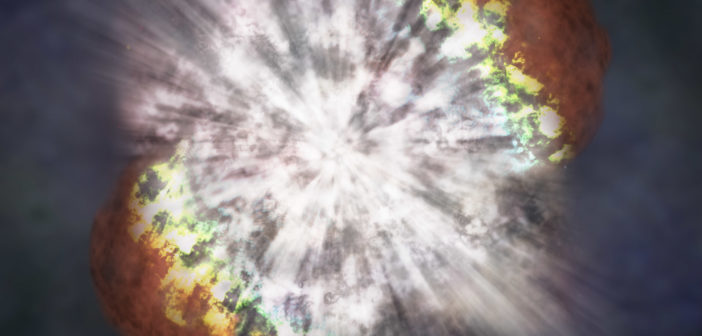What causes the bizarre, extragalactic fast radio bursts we’ve detected over the last decade? A new study of an unusually bright supernova may have found the key to answering this question.
Clues from a Repeating Burst
When a mysterious millisecond radio pulse of extragalactic origin — a fast radio burst (FRB) — was recently found to repeat, it gave astronomers a rare chance to hunt down this source’s host galaxy. FRB 121102 was isolated to a star-forming, low-metallicity dwarf galaxy located roughly 3 billion light-years away, and a dimmer, persistent radio source was discovered in the same region that produced the bursts.This localization lent support to one theory for the origin of FRB 121102 (and possibly other FRBs): that the bursts are powered by a magnetized neutron star born decades ago in a superluminous supernova.
Magnetar Culprit?
Superluminous supernovae are a type of stellar explosion at least ten times more powerful than standard supernovae. These supernovae may shine extra bright due to the birth of a neutron star with extremely strong magnetic fields — a magnetar — that spins on millisecond timescales, emitting radiation and winds as its magnetic fields decay and further powering the explosion.

Artist’s impression of a magnetar — an extremely magnetized neutron star — in a young star cluster. [ESO/L. Calçada]
A team of scientists has now sought to test this picture by examining known superluminous supernovae and searching for signs of co-located persistent or bursting radio sources. In a recent publication led by Tarraneh Eftekhari (Harvard-Smithsonian Center for Astrophysics), they detail their first success.
Radio Source Found
Using the Very Large Array, Eftekhari and collaborators discovered a persistent radio source coincident with the superluminous supernova PTF10hgi, an explosion that went off 7.5 years ago, roughly 1.5 billion light-years away. This is the first time a radio source of any kind has ever been associated with a superluminous supernova, providing an important link between these explosions and other phenomena.

Left: Radio continuum map from VLA 6-GHz observations of PTF10hgi. Right: Near-ultraviolet image of the host galaxy of PTF10hgi from Hubble, with radio contours overlaid. The small red circle shows the optical position of PTF10hgi. [Eftekhari et al. 2019]
Instead, the radio emission is extremely reminiscent of the persistent radio source associated with FRB 121102. The authors show that all of the observations are consistent with a magnetar central engine powering a glowing nebula embedded in the supernova ejecta. And while a bursting radio source wasn’t found coincident with the supernova, the authors’ observations were only 40 minutes long; a longer observation time may yet discover a co-located FRB.
The authors detail future observations that should be able to rule out alternative origins for the radio emission and strengthen the case for a superluminous-supernova-born magnetar as a source of fast radio bursts. In the meantime, it’s exciting to watch as the pieces of this puzzle start to come together!
Citation
“A Radio Source Coincident with the Superluminous Supernova PTF10hgi: Evidence for a Central Engine and an Analog of the Repeating FRB 121102?,” T. Eftekhari et al 2019 ApJL 876 L10. doi:10.3847/2041-8213/ab18a5


8 Comments
Pingback: Daily Study Log (2019-05-03) | Study Astrophysics
Pingback: MAGNETAR PODE SER A SOLUÇÃO PARA O MISTÉRIO DAS FRBS | SPACE TODAY TV EP.1811 | Mestre Jedi
Pingback: A Link Between Fast Radio Bursts, Magnetars, and Supernovae? – Sky & Telescope | SPACE FORCE
Pingback: A Link Between Fast Radio Bursts, Magnetars, and Supernovae? – AstroBrief
Pingback: A Link Between Fast Radio Bursts, Magnetars, and Supernovae? – Sky & Telescope - monsterbizx
Pingback: A Link Between Fast Radio Bursts, Magnetars, and Supernovae? - Worldika - New Platform For Explore World
Pingback: A Link Between Fast Radio Bursts, Magnetars, and Supernovae? – Dinezh.com
Pingback: An Update on Fast Radio Bursts: New Discovery in Our Own Galaxy